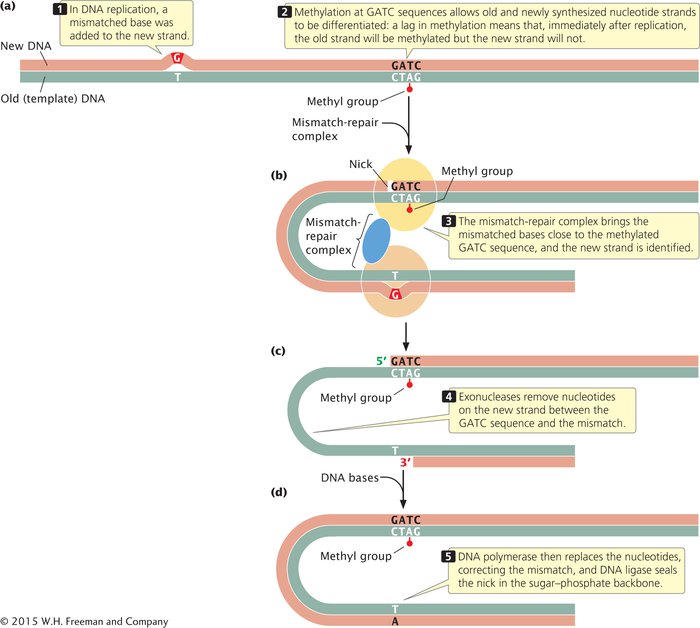Types of DNA Repair
One type of DNA repair is mismatch repair, which corrects incorrectly inserted nucleotides that escape proofreading by DNA polymerase during replication (Figure 13.26). Distortions caused by incorrectly paired bases are detected by mismatch-repair enzymes. A complex of mismatch-repair enzymes then cuts out the distorted section of the newly synthesized strand, and DNA polymerase fills the gap with new nucleotides, using the original DNA strand as a template. The template strand is recognized by the presence of methyl groups on special sequences of that strand.

13.26 Many incorrectly inserted nucleotides that escape proofreading are corrected by mismatch repair.
Another type of DNA-repair mechanism is direct repair, which does not replace altered nucleotides, but instead restores their original (correct) structures. For example, direct repair corrects O6-methylguanine, an alkylation product of guanine that pairs with adenine, producing G • C → T • A transversions. An enzyme called O6-methylguanine-DNA methyltransferase removes the methyl group from O6-methylguanine, restoring the base to guanine (Figure 13.27).

13.27 Direct repair restores the original structures of nucleotides.
In base-excision repair, a modified base is first excised and then the entire nucleotide is replaced. The excision of modified bases is catalyzed by a set of enzymes called DNA glycosylases, each of which recognizes and removes a specific type of modified base. Uracil glycosylase, for example, recognizes and removes uracil produced by the deamination of cytosine. Other glycosylases recognize hypoxanthine, 3-methyladenine, 7-methylguanine, and other modified bases.
Page 365
A final repair pathway that we’ll consider is nucleotide-excision repair, which removes bulky DNA lesions (such as pyrimidine dimers) that distort the double helix. In nucleotide-excision repair, the two strands of DNA are separated and a section of the DNA containing the distortion is removed; the resulting gap is filled in by DNA polymerase, and DNA ligase seals the gap in the sugar–phosphate linkage. Nucleotide-excision repair can repair many different types of DNA damage. It is found in cells of all organisms from bacteria to humans and is among the most important of all repair mechanisms.
CONCEPTS
A number of pathways exist for the repair of DNA. Most require two nucleotide strands because a template strand is needed to specify the correct base sequence.

